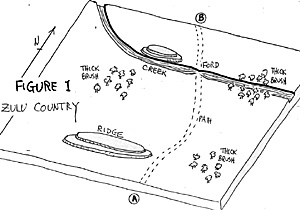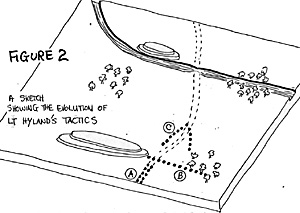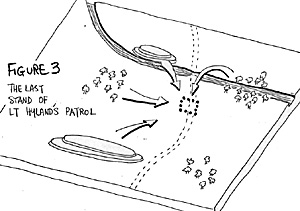The regular reader of the REVIEW will have noted that, in the last few issues, there seems to have been a run on British/Zulu battles. And with good reason... your friendly editor, stimulated by Larry Brom's The Sword And The Flame (TSATF) has amassed a number of figures sufficient to put a small size encounter on the table. Unfortunately, not enough castings have been assembled to provide a full size game under TSATF rules, which require 20-man units, with the ratio of Zulu units to British ranging anywhere from 4 or 5 to 1. Until sufficient figures are accumulated, therefore, we'll warm up for the larger scale TSATF battles with the present series of skirmishes.
The author has, by various and devious methods, induced several PW members to engage in these skirmishes and the present encounter matched Lt. Edward Hyland, an Officer of the Queen, in command of a 12 man British patrol (13 men in all), against Kevin M'Donga Donovan. M'Donga's 40 or so Zulus were intent upon preventing Hyland's patrol from crossing Zulu territory.
 Figure 1 is sketch of the terrain; Lt. Hyland's mission was to
get his patrol from point A to B, a seemingly simple task. M'Donga
Donovan's mission, of course, was to cause the British War Minister
to recruit 13 more troops to take up the slack.
Figure 1 is sketch of the terrain; Lt. Hyland's mission was to
get his patrol from point A to B, a seemingly simple task. M'Donga
Donovan's mission, of course, was to cause the British War Minister
to recruit 13 more troops to take up the slack.
A NOTE ON THE SEQUENCE
The key to the skirmish was the sequence, an "impulse" method described in the REVIEW and the COURIER... which has been successfully used by kiddies from 6 to 60. It was surprising, therefore, when, in the initial stages of the skirmish, it was noted that both Lt. Hyland and M'Donga Donovan had a wee bit o' trouble in coming to grips with the logic of the sequence.
While M'Dongals difficulty iS understandable - after all, the lad is just a simple Zulu warrior - it was difficult to understand why Lt. Hyland, fresh from Sandhurst, experienced any problem. Difficult, that is, until we investigated Lt. Hyland's boast that he had graduated 5th in his class at Sandhurst, and discovered there were only 6 in the class! We're not sure who the 6th ranker was, but we would evidence no surprise if he, too, was a PW member.
Whatever, the sequence, in brief, consists of the following phases:
a. Throw dice to determine A and B
b. A now states in logical fashion, several possible actions for his troops ...
- A1. I may hold and fire.
A2. I may advance.
A3. I may wheel left.
c. B states what he'd do in response to each of A's options...
- B1. If A holds (A1), I'll advance.
B2. If A advances (A2), I'll fire.
B3. If A wheels left (A3), I'll charge.
d. A now selects one of the options he listed. B must then follow through with his stated response. Thus if, as above, A elects to advance (A2), B must fire (B2). Both parties, it may be seen, are locked into a specific action/reaction pattern.
e. The only question remaining is: when does B fire? Before or after A advances? B, being the impacting unit, has a 70% chance to fire when he wants. Thus if he wishes to hold his fire until after A advances thereby-getting in a volley at the closer range, he rolls the dice ...
- 01 - 70 ... he fires after A moves up
71 - 100 ... he fires before A moves up
The reason for the above review of the sequence is to zero in on why M'Donga and Lt. Hyland were having difficulty adhering to the procedure. It turned out that the critical problem area was in Step (b), wherein A announces his options.
Whenever Lt Hyland won the dice toss and proceeded to state his options, it was obvious that he called upon his Sandhurst training, in particular, an advanced course called Cautious Patrol Tactics 309. Hyland would leave nothing to chance. Each turn, he would elaborate on his options:
- 1. I may hold ...
2. I may fire...
3. I may wheel left ...
4. I may wheel right ...
5. I may form square ...
6. I may advance ...
And so on and so on and so on... Lt Hyland was determined to leave no stone unturned. He was one patrol leader that was not going to be surprised by a miscreant pack of Zulus. Poor M'Donga Donovan, not having the benefit of a Sandhurst education, and being deluged with Hyland's options, was understandly confused.
For the most part, M'Donga sought the simple way out; during the first turns of the game, he merely stated: "My Zulus will remain hidden."
After awhile, however, M'Donga caught on to the swing of things, and it will be seen how he eventually got the Lieutenant's patrol in a position wherein he could triumphantly shout: "Gotcha!"
THE SKIRMISH
 Lt Hyland's patrol started out on the road, swinging smartly out in column formation at 9 inches per
turn. See point A in Figure 2. He had almost reached the first ridge, when 6 musket bearing warriors
appeared on the crest.
Lt Hyland's patrol started out on the road, swinging smartly out in column formation at 9 inches per
turn. See point A in Figure 2. He had almost reached the first ridge, when 6 musket bearing warriors
appeared on the crest.
The muskets fired with no effect, and the patrol fanned out into line and fired back with a "hasty fire" modifier (since they fired after movement). Three Zulus fell; no British were hit. Firing procedures were those described in the [March REVIEW] using a nomograph to account for figures firing, rangetcover, etc.
M'Donga, on the next turn, pulled his musket bearers back under cover before the patrol could get in another shot at them. The good. Lieutenant, now having been baptized under fire, decided that maintaining column formation was not the thing to do in Zulu country; his men, shoulder to shoulder, advanced in line, 6 inches per turn, across the veldt. See point B in Figure 2.
As the patrol came on, they swept the dense bush to their right, finding no one. They reached the ridge and, once again, the 3 remaining warrior-musketeers chose to fire on them.
Deigning even to face his unit towards the ineffective musketeers, Lt. Hyland, forsaking his years of training at Sandhurst, cried: "This is how they do it in the movies!"
He formed his unit into a closely packed wedge, or V, 6 men on a side. The 6 facing the Zulu musket bearers fired hastily, and another Zulu dropped. Back into cover went the 2 surviving musketeers. See point C in Figure 2.
All readers will have knowledge of the famed "British square"... now they can add the famous Hyland "British V", which advanced, during the course of several turns, almost reaching the ford.
M'Donga, by this time, impatient after remaining hidden so long, no longer restrained his troops, and the entire Zulu contingent commenced a charge at the British. Hyland quickly turned his "V" into a square.
 Figure 3 sketches the 4 areas from which the charge (12
inches) of the Zulus began. Luckily for the British, the initial
charge of 3 of the 4 groups fell short; the unit emerging from
the brush on the far side of the creek reached the square one
full turn before the other groups.
Figure 3 sketches the 4 areas from which the charge (12
inches) of the Zulus began. Luckily for the British, the initial
charge of 3 of the 4 groups fell short; the unit emerging from
the brush on the far side of the creek reached the square one
full turn before the other groups.
This, meant that, except for the contacting unit, the patrol was given an extra shot at the other charging Zulus. Four sides of the square fired, several Zulus fell, but the only effect was to cause one small Zulu band to rout to the north.
Zulu morale checks were done in groups of 5; using a 10-sided die, a morale failure for the 5 man unit was occasioned by a throw of 1 for 1 casualty, 1 or 2 for 2 casualties, 1 or 2 or 3 for 3 casualties, etc. Thus only small groups of Zulus would rout at any given time; the main body would continue to advance.
Melee consisted of a basic pairing-off of figures. Each man received one or more dice depending upon his status and situation:
- Status:
British Officer 12 sided die
British soldier 10 sided
Zulu 12
Situation:
Impetus 4 sided (contact round only)
British compact formation 4
A difference of 2 on the dice throws was required for a kill.
On the first contact, 3 British fell along with 3 Zulus, an excellent trade-off for M'Donga Donovan. As the melee continued, round by round, the Zulus took their toll and the square became smaller. Lt Hyland fell victim to an untimely dice roll in his very first combat... the square became smaller still.
A good fight by the British, but M'Donga would not be stopped. At battle's end, the casualty listings were in the order of:
- British... 13 (the entire patrol)
Zulus ... 30 (out of 43 figures)
Back to PW Review December 1981 Table of Contents
Back to PW Review List of Issues
Back to MagWeb Master Magazine List
© Copyright 1981 Wally Simon
This article appears in MagWeb (Magazine Web) on the Internet World Wide Web.
Other military history articles and gaming articles are available at http://www.magweb.com